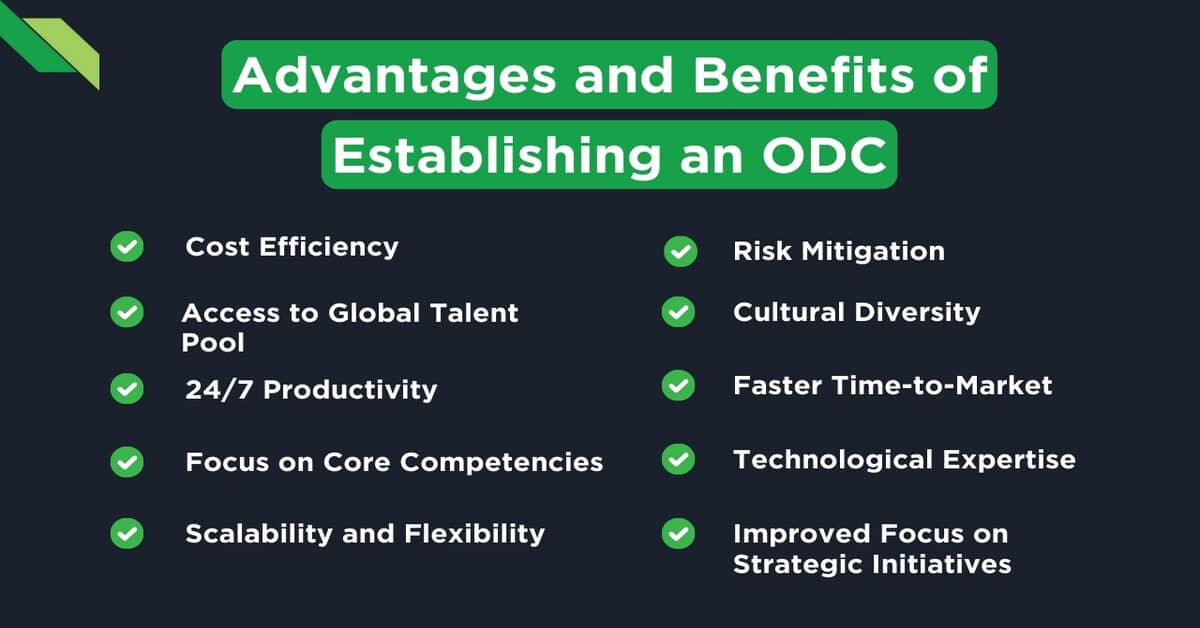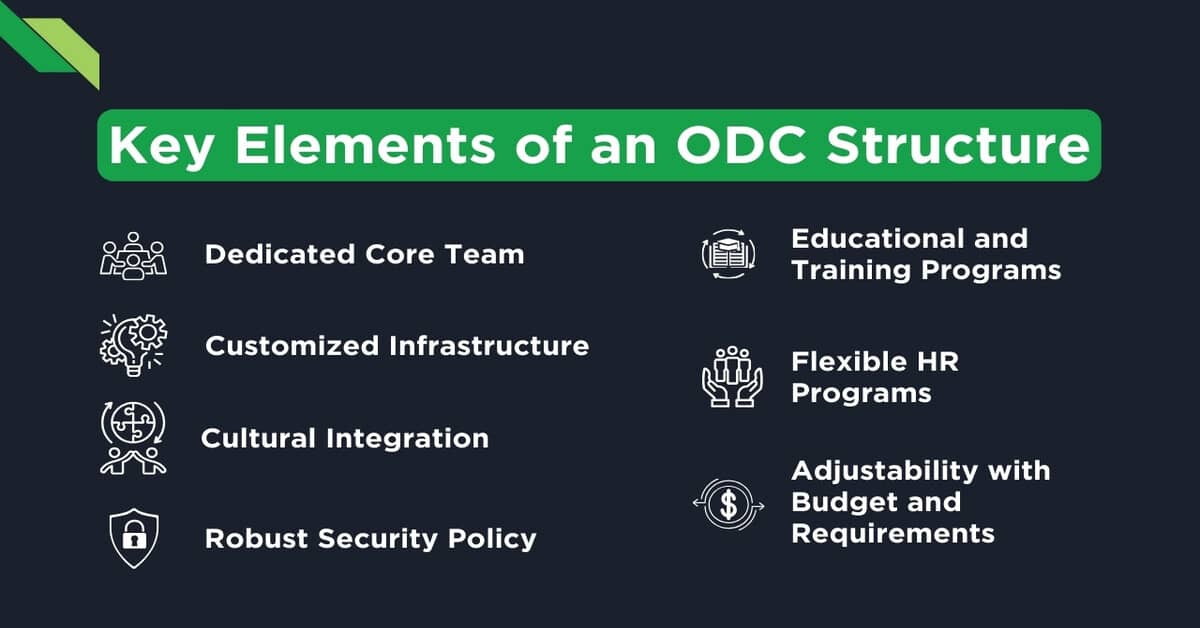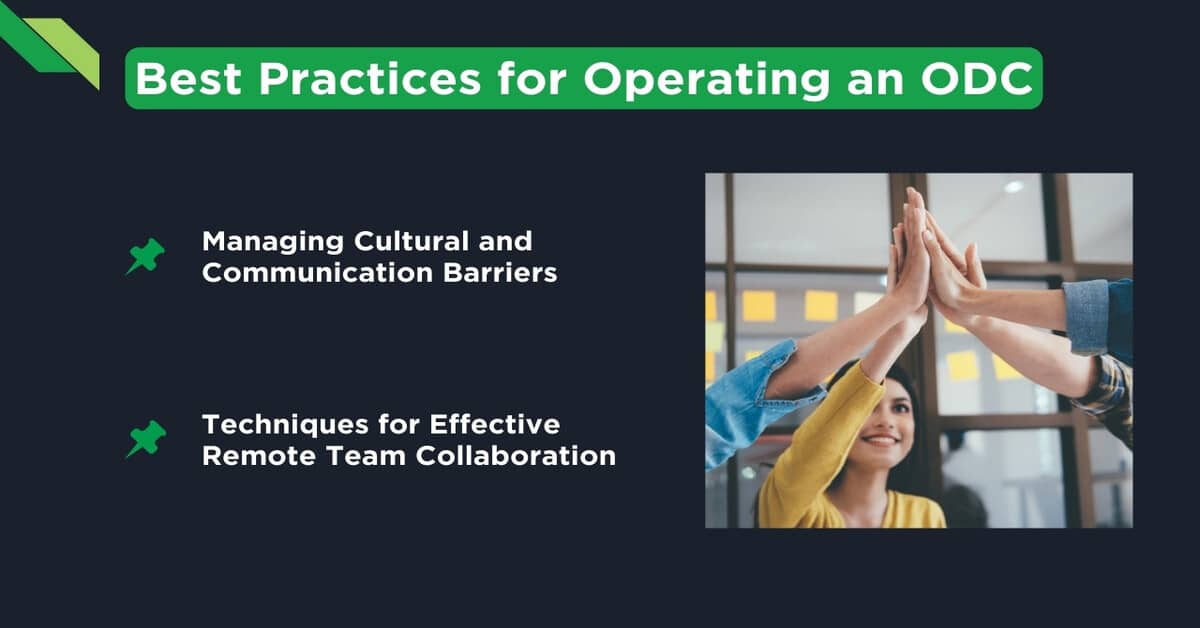Last Updated on 2025-06-25
Welcome to the world of remote offices!
It’s a realm where geographical boundaries blur in the background of technology. And companies, big and small, harness the power of global collaboration.
Let’s dive into the fascinating industry of Offshore Development Centers (ODCs) specializing in mobile, website, and software development. This is your potential strategic asset in the highly competitive tech landscape.
Offshore Development Center (ODC) Definition
An Offshore Development Center (ODC) is more than just a business trend. It’s a comprehensive process structured to be a full-fledged foreign extension of an organization.
Think of it as your company’s branch office, where the offshore development center, which includes a strong backend team, works effectively. It is powered by a cross-functional dedicated team equipped with all the required tech tools in a country with significantly lower living costs.
The concept of ODCs has matured significantly through the years. Initially, ODCs were all about saving costs. Now, it means so much more.
It’s about stepping into new markets, ensuring around-the-clock productivity due to different time zones, and addressing talent gaps by tapping into a global pool of experts.

Advantages and Benefits of Establishing An ODC
Establishing an Offshore Development Center (ODC) offers numerous advantages for businesses. This model benefits those seeking to optimize their operations and gain a competitive edge in today’s dynamic market.
The benefits of offshore development center setup include:
- Cost Efficiency: ODCs provide access to skilled developers in regions with lower labor costs. This allows businesses to achieve significant cost savings without compromising talent.
- Access to Global Talent Pool: ODCs enable organizations to tap into a diverse and extensive talent pool. It brings together professionals with a range of skills and expertise worldwide.
- 24/7 Productivity: With teams distributed across different time zones, ODCs facilitate round-the-clock productivity, accelerating project timelines and ensuring continuous progress.
- Scalability and Flexibility: ODCs offer scalability to adapt to project demands. This allows businesses to expand or downsize their teams based on project requirements quickly.
- Focus on Core Competencies: By outsourcing non-core functions to an ODC, businesses can concentrate on their core competencies while fostering innovation and growth.
- Risk Mitigation: ODCs provide risk mitigation through geographic diversification, minimizing the impact of regional disruptions or unforeseen challenges on business operations.
- Cultural Diversity: Collaboration with teams from diverse cultural backgrounds enhances creativity, problem-solving, and overall team dynamics. This leads to a more inclusive and innovative work environment.
- Faster Time-to-Market: ODCs contribute to more rapid development cycles. It helps businesses bring products and services to market more swiftly and gain a competitive advantage.
- Technological Expertise: Access to specialized skills and cutting-edge technologies in ODC locations ensures that businesses stay abreast of the latest advancements in their industry.
- Improved Focus on Strategic Initiatives: Outsourcing routine tasks to an ODC allows businesses to redirect their internal resources toward strategic initiatives, driving long-term growth and innovation.
7 Key Elements of A Dedicated ODC Structure
Project goals should align with the client’s requirements and effective communication protocols. These protocols include regular meetings and updates that are crucial for seamless collaboration.
An ODC structure also relies on well-established project management methodologies, quality assurance processes, and reporting mechanisms to ensure transparency and accountability.
Efficient resource allocation, adherence to timelines, and stringent security measures contribute to a resilient ODC structure. It fosters a successful and streamlined partnership between the client and the offshore development team.
At the heart of an ODC structure are several key elements that ensure its smooth operation.
- Dedicated Core Team: A devoted offshore software development team lies at the foundation. It often comprises developers, testers, project managers, and support staff. These professionals are the driving force behind the ODC, aligning with your company’s processes and ethos.
- Customized Infrastructure: Every ODC is equipped with tailored infrastructure. This ensures the right technologies and facilities are in place for the team to operate effectively and efficiently.
- Cultural Integration: Your corporate culture continues beyond the water’s edge. An ODC imbibes your brand and replicates the workplace environment, providing a seamless cultural transition for employees.
- Educational and Training Programs: Custom-built programs ensure continuous learning and skill enhancement. Which makes it easier to align the team’s capabilities with your evolving tech needs.
- Robust Security Policy: Securing your data and intellectual property is paramount. ODCs institute stringent security protocols that echo your standards.
- Flexible HR Programs: A flexible and dynamic HR approach allows for scaling operations and agility in team management, adapting to project demands.
- Adjustability with Budget and Requirements: ODCs can easily be scaled up or down to match budget fluctuations and project requirements. So financial viability without compromising on delivery is possible.
This forward-thinking mindset development team setup can give you a clear view of what’s ahead. And it enables you to steer your offshore team toward a future mapped out by shared goals and mutual success.

Operational Models of ODCs
They range from basic rental models—where you rent space and resources. Or fully managed models, where the service provider oversees everything from hiring to daily operations. Understanding your needs and potential infrastructure costs will determine your ideal operational model.
You have various models for structuring your Offshore Development Center’s operation. Here’s a brief look at the predominant operational frameworks:
- Customer Model: Under this arrangement, the ODC functions practically as a subsidiary of the parent company. The offshore team members are your employees, devoted solely to your projects, guided by senior on-site personnel responsible for key decision-making and overall management. This model fosters strong alignment with corporate culture and process integration.
- Contractor Model: A slightly more hands-off approach, the contractor model has the offshore team comprised of personnel who are not your full-time employees. They work on your projects but are managed by the contracting firm, which simplifies the staffing aspects but can offer less control over team culture and engagement.
- Hybrid Model: As the name suggests, the hybrid model blends elements from customer and contractor models. This can vary greatly depending on your organization’s needs and strategic outlook.
- ODC Classic: This legacy model continues to be a preferred choice for many businesses. The ODC Classic features a dedicated team with essential technical skills under the guidance of a manager. This model emphasizes understanding and meeting customer expectations through collaborative engagement.
- Build-Operate-Transfer (BOT): This model allows you to build and establish the ODC, operate it to stabilize processes, and, eventually, transfer the entire setup as a captive center.
Each operational model has unique advantages and fits different strategic outlooks of varying organizations. Whether you’re looking for complete control over your projects or need flexible teams managed by third-party contractors, the suitable model can shape the future success of your ODC.
When to Consider Offshore Software Development Center Services
Now, let’s discuss why you might consider an Offshore Development Center (ODC) for your business.
Assessing whether a dedicated ODC aligns with your business needs is vital before taking the plunge. Here’s a bird’s eye view of the metrics you should evaluate.
- Expansion Goals: If your goals include scaling operations, entering new markets, or requiring a more substantial workforce than is available locally, an ODC might be a strategic fit.
- Technical Skill Requirements: When the talent pool in your vicinity needs to improve on the advanced technical skills your projects demand, consider an ODC with global experts to bridge this skill gap.
- Budget Constraints: If budget constraints are tightening your progress, the cost-efficiencies of an ODC can provide the financial breathing room to grow without compromising quality.
- Long-Term Strategy: ODCs are ideal for long-term partnerships rather than short-term projects. Evaluate your roadmap, and if it extends beyond immediate needs, ODCs can provide the necessary continuity and commitment.
- Cultural Fit: Consider if you have the infrastructure to integrate a diverse team into your company culture to ensure smooth collaboration and communication.
- Security and Compliance: Legal and security implications—including data protection laws and intellectual property rights—should align with your business standards and requirements.
Undertake a thorough analysis to understand the intricacies of your business needs before deciding if an ODC is the right choice.
With the right preparation, an ODC can become more than just an offshore unit. It can transform into a powerhouse driving your company’s innovation and growth.

6 Key Indicators that Your Company Could Benefit From An ODC
You may be browsing the possibilities of global expansion or effective human resource management and need to know where an Offshore Development Center fits into your story.
Let’s clear the air with clear indicators that your company is ready to reap the benefits of an ODC:
- Rapid Business Growth: If your business is growing faster than you can hire, an ODC provides immediate access to established teams so you can keep pace.
- Lack of Specialized Talent Domestically: When your local market runs dry of the specialized skills necessary for your tech endeavors, it’s time to turn to a wider, international talent pool.
- Inconsistent Product Development Cycles: The need for continuous development cycles and faster time-to-market can be efficiently met with an ODC operating in a different time zone.
- Need for Scalability: An ODC’s flexible resource allocation becomes a key solution if your project load fluctuates, creating staffing challenges.
- Efforts to Optimize Costs: When aiming to reduce operational and development costs without cutting corners on talent quality, an ODC can balance the scales in your favor.
- Strategic Focus Shift: If you plan to focus more on core business activities and need a trustworthy partner to handle development processes, an ODC can shoulder that responsibility.
Tick off these signs, and you’re likely a prime candidate for the strategic leap into Online Digital Communities (ODCs), especially for startup companies looking to propel their business forward technologically and solidify their presence as a global player in the industry.
Setting Up An Offshore Development Center
Building bridges between diverse teams and unlocking new avenues for growth requires businesses to consider initiating an Offshore Development Center (ODC). Find out how to set up a dedicated offshore software development center.
Choosing the Right Location for Your ODC Service
The decision of where to set up your Offshore Development Center is significant. Choosing the right location can influence the success of your ODC by impacting costs, talent availability, and overall operations. Here are the criteria for how you can make an informed choice:
- Talent Availability: Look for regions renowned for their educational systems and technical expertise. A rich talent pool is vital for the sustainability of your ODC.
- Cost Efficiency: While low cost is attractive, always balance it against the quality of infrastructure and the talent available. Remember, there are better long-term strategies than the cheapest option.
- Cultural Compatibility: Find an offshore destination where the work culture aligns with your own. This fosters easier communication and integration.
- Political and Economic Stability: A stable environment is crucial for the longevity of your ODC. Assess the political climate, legal framework, and economic policies that affect business operations.
- Government Regulations and Incentives: Some regions offer incentives for setting up ODCs, while others might have stringent regulations. Understanding these can help you navigate through bureaucratic processes smoothly.
- Connectivity and Time Zone Advantages: Being in a location with a favorable time difference allows for round-the-clock operations, and excellent connectivity ensures seamless collaboration with the home office.
Steps Involved in Establishing an ODC
Embarking on the journey to establish an Offshore Development Center (ODC) can be an exciting venture for your company. Let’s break down this process:
- Market Analysis: Begin with thorough research on potential locations for your ODC. Assess the talent pool, cost of living, infrastructure quality, and legal considerations.
- Establish Legal Entity: You must register within the local government as a legal entity. This often includes understanding and complying with business, taxation, and employment laws.
- Facility Setup: Find and rent an office space that suits your budget and needs. Choose an attractive area for potential employees, like city centers or burgeoning tech hubs if possible.
- Office Design and Setup: Tailor the interior design to reflect your corporate identity and values while ensuring it promotes productivity. Also, plan for any necessary renovations to accommodate your team and equipment.
- Infrastructure and Security: Invest in the necessary technology infrastructure and robust security measures that match your company’s standards, from secure internet connections to specialized software.
- Recruitment and Training: Build your team by recruiting locally. Look for candidates that match the skill requirements and resonate with your company culture. Implement training programs to acclimate new hires to your processes and expectations.
- Establishing Workflows: Create clear operational protocols and communication channels for seamless collaboration between your offshore and on-site teams.
- Maintenance and Growth: Once established, regularly monitor and adjust your ODC’s operations to ensure continuous improvement and scalability to match your business’s evolving needs.
Taking these methodical steps can solidify the foundation of your ODC, thereby enabling a harmonious extension of your business that drives value from a distance.
Best Practices for Operating an ODC

Managing Cultural and Communication Barriers
Navigating cultural and communication barriers, including an effective onboarding process, is pivotal to the success of an Offshore Development Center.
Here’s how you can achieve a harmonious work environment regardless of geographic and cultural distances:
- Cultural Sensitivity Training: Implement training programs for both onshore and offshore teams to promote understanding of each other’s cultural norms and work ethics.
- Language Proficiency: Ensure that the offshore team either has or receives training in the language your company primarily uses for business to avoid miscommunication.
- Seamless Communication Channels: Utilize modern tools and platforms that facilitate instant messaging, video conferencing, and project management, ensuring consistent and clear communication.
- Regular Interactions: Schedule frequent interactions, not just work-related but also casual meetups, to foster team bonding and minimize the feeling of ‘us’ versus ‘them.’
- Clear Documentation and Processes: Maintain clear and comprehensive documentation for processes that can serve as an easy reference point and minimize misunderstandings.
- Respect for Time Zones: Be respectful of the offshore team’s working hours when scheduling meetings, and try to find a suitable overlap that works for all parties involved.
Be proactive and create a culture of open communication and mutual respect. So you can turn these potential barriers into building blocks for a strong, cohesive global team.
Techniques for Effective Remote Team Collaboration
In the world of Offshore Development Centers, collaboration is king. Establishing effective remote collaboration techniques with your offshoring team is crucial with members spread across the globe.
Follow these tips to enhance team cohesion and productivity.
- Utilize Collaborative Tools: Embrace project management software, portfolio or resource collaboration, communication platforms, and cloud-based services that allow real-time updates and seamless teamwork.
- Regular Check-ins: Schedule daily or weekly meetings to discuss project status, immediate priorities, and any roadblocks team members may face.
- Defined Roles and Expectations: Clearly outline each team member’s responsibilities and the expectations associated with their role to avoid confusion and ensure accountability.
- Encourage Open Communication: Create an environment where team members feel comfortable sharing ideas, expressing concerns, and asking questions. This openness can lead to innovative solutions and a cohesive team dynamic.
- Document Sharing and Version Control: Ensure all documents are easily accessible in a shared space, with strict version control practices to avoid conflicts or duplication of work.
- Time Zone Management: Craftwork schedules that maximize the productivity of each team member while allowing for overlap times where real-time collaboration can occur.
- Virtual Team Building: Initiate activities that are not work-related to help teams connect on a personal level, such as virtual coffee breaks, online games, or shared learning sessions.
By implementing these techniques, every team member feels included, heard, and instrumental to the team’s success. No matter where they are located.
Comparing ODCs to Traditional Outsourcing
As you weigh the options between an Offshoring Development Center model and traditional outsourcing, it’s essential to understand how they differ and how they might share certain similarities.
Take a look at this concise comparison to guide your decision-making process.
| Differences | Similarities |
| Control and Oversight | Cost Efficiency |
| Team Structure | Access to Talent |
| Cultural Integration | Focus on Core Operations |
| Investment and Commitment | Scalability |
Differences
- Control and Oversight: ODCs tend to operate as extensions of the parent company, offering more control over the team and processes, whereas, with traditional outsourcing, control is often in the hands of the third-party vendor.
- Team Structure: An ODC typically involves a dedicated team working exclusively for you, whereas traditional outsourcing might involve shared resources across multiple clients.
- Cultural Integration: ODCs often strive to replicate the client company’s culture within the offshore team, promoting a unified work environment, unlike traditional outsourcing, where cultural alignment might be less emphasized.
- Investment and Commitment: Setting up an ODC is a long-term strategic investment, signaling a committed relationship compared to the project-based, transactional nature of traditional outsourcing.
Similarities
- Cost Efficiency: Both models offer the potential for cost savings due to lower labor and operational costs in offshore locations.
- Access to Talent: They provide access to a global talent pool, alleviating local skill shortages.
- Focus on Core Operations: Both allow companies to outsource non-core functions to focus on strategic business areas.
- Scalability: ODCs and traditional outsourcing provide the flexibility to scale operations up or down based on business demands.
By understanding these key points, you can better ascertain which model aligns with your business functionality, operational needs, strategic goals, and cultural ethos. This helps you make an informed choice appropriate for your business.
Deciding Between An ODC and Outsourcing Based on Your Needs
Choosing between an Offshore Development Center (ODC) and traditional outsourcing practices hinges on thoroughly analyzing your business requirements, long-term strategies, and operational preferences. Here’s how to align these models with your needs:
- Long-term vs. Short-term Projects: If you’re looking at long-term engagement with consistent work, an ODC can be more beneficial. For short-term or one-off projects, traditional outsourcing may be more appropriate.
- Level of Control and Involvement: An ODC allows greater control over the workforce and processes. If you prefer to have a direct hand in management and operations, opt for an ODC. Outsourcing works well if you’re comfortable delegating these roles to a vendor.
- Cost Considerations: While both options offer cost savings, traditional outsourcing may require less upfront investment than setting up an ODC, which could involve infrastructure and staffing investments.
- Cultural Alignment: If having a team that integrates with your company culture is important, an ODC is the way to go. With outsourcing, cultural fit is less guaranteed.
- Expertise and Specialization: If you require highly specialized skills and want dedicated attention, an ODC can provide a focused team. Outsourcing can also offer expertise but may involve shared attention across clients.
- Risk Management: Consider risk tolerance levels. An ODC requires more commitment and may have higher stakes, whereas outsourcing can be more flexible, with vendors typically managing risks.
By weighing these considerations against your business goals and desired engagement level, you can make a strategic choice that results in operational success and strong ROI. Remember, the right choice will align closely with your company’s mission, operational style, and growth trajectory.
Unlock Success with Offshore Development
Full Scale is a dedicated offshore development center in the Philippines. We have already rendered more than 3 million coding hours to our clients. And we are ready to offer IT staff augmentation services to more businesses.
So if you’re looking for an ODC partner, here are the top five reasons why you should work with us:
- Proven Expertise: With a robust track record, Full Scale brings a wealth of experience, showcasing proficiency across diverse industries and technologies. Our proven expertise ensures your projects are in capable hands.
- Dedicated Teams: Experience personalized attention with our commitment to providing dedicated staff augmentation services. Our teams are tailored to your unique needs and ensure focused collaboration and optimal project outcomes.
- Cost Efficiency: Full Scale leverages the economic advantages of the Philippines, offering cost-effective solutions without compromising quality. Elevate your project’s efficiency while maximizing your budget.
- Innovative Solutions: Stay ahead of the curve with our commitment to innovation. Adapting to emerging technologies and industry trends, we provide forward-thinking solutions that position your business at the forefront of competitiveness.
- Cultural Alignment: We foster seamless collaboration through cultural alignment. The Philippines’ affinity with the Western world eliminates communication barriers, ensuring a harmonious working relationship for enhanced productivity.
Explore the unparalleled advantages of partnering with a dedicated offshore development company and leveraging staff augmentation services in the Philippines.
Schedule A Discovery Call
FAQs Related to Offshore Development Centers
How Do Offshore Development Centers Differ From Traditional Outsourcing?
Offshore development centers offer a dedicated team working exclusively on your projects under your control and supervision, providing better integration with your company’s culture and goals. In contrast, traditional software outsourcing involves hiring a third-party vendor on a project basis, often shared among various clients, with less direct control over operations.
What are the Typical Challenges Associated with Managing an ODC?
Developers face typical offshore software development challenges, like cultural differences, communication barriers due to language and time zone discrepancies, maintaining consistent quality standards, data security concerns, and managing the legal complexities of operating in a foreign country. Proper planning and strategies are essential to overcome these hurdles.
Can Small Businesses Benefit From Setting up an Offshore Development Center?
Small businesses can benefit from tapping into the outsourcing industry by setting up an offshore development center. This grants them access to affordable specialized skills and technology, which can be cost-prohibitive domestically. It provides scalability for growth without the need for a large upfront investment in local resources, infrastructure, or technology.

Matt Watson is a serial tech entrepreneur who has started four companies and had a nine-figure exit. He was the founder and CTO of VinSolutions, the #1 CRM software used in today’s automotive industry. He has over twenty years of experience working as a tech CTO and building cutting-edge SaaS solutions.
As the CEO of Full Scale, he has helped over 100 tech companies build their software services and development teams. Full Scale specializes in helping tech companies grow by augmenting their in-house teams with software development talent from the Philippines.
Matt hosts Startup Hustle, a top podcast about entrepreneurship with over 6 million downloads. He has a wealth of knowledge about startups and business from his personal experience and from interviewing hundreds of other entrepreneurs.





